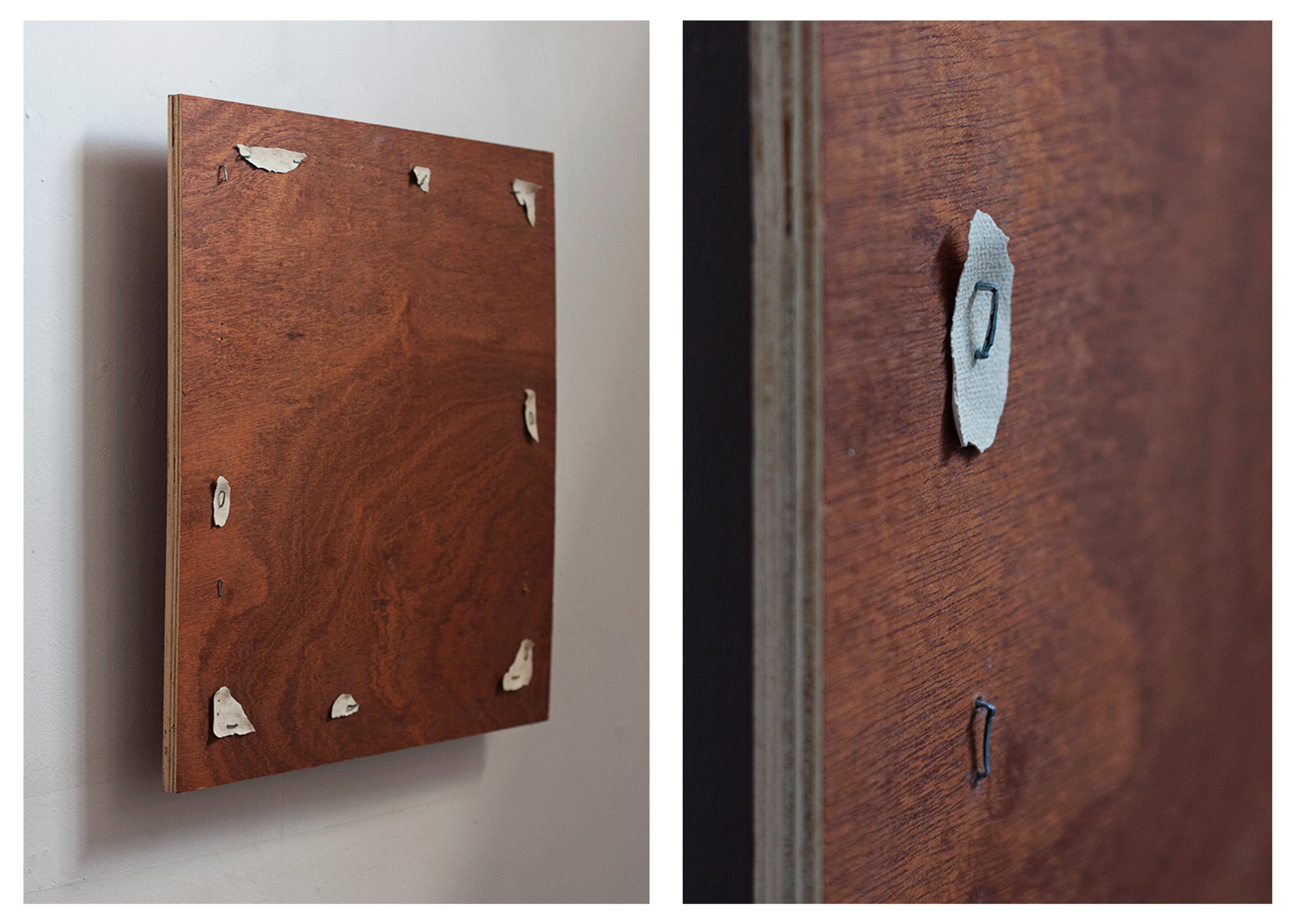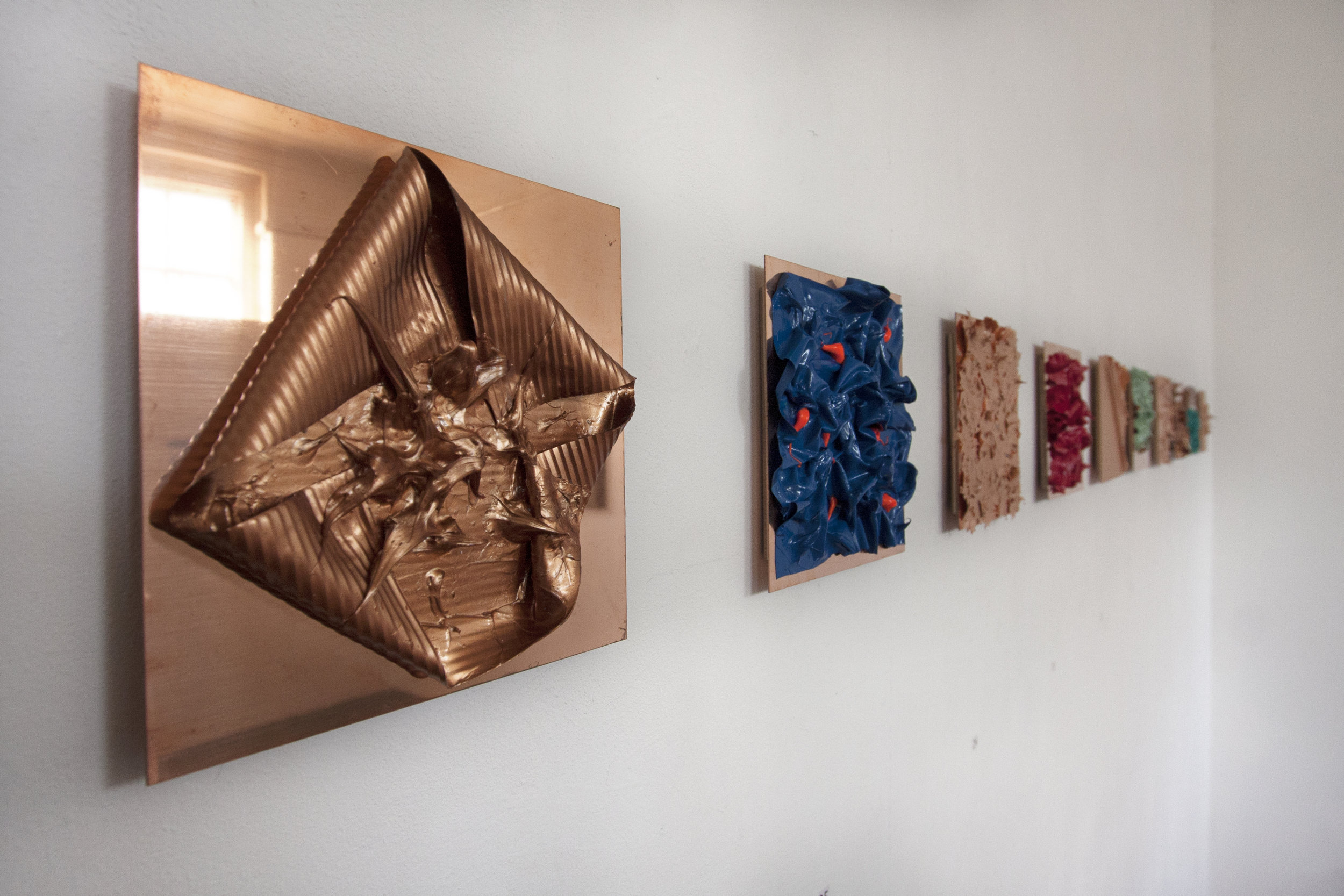Brendan Lyons is a painter who has exhibited for many years producing stand alone and site specific work. He is based at the Bridewell where I interviewed him in his studio.
We started by looking at a work about a foot square made of a wooden board and what looks like scraps of stapled canvas left as if the majority of canvas had been ripped off.
IF I was blown away by the incredible trompe l’oeil effect in your work. Can you tell me a bit about how you create this and why you use it?
BL I started by drawing. Making the canvas and staples by drawing on paper and adding them to the board. They were in the Jerwood drawing prize a couple of times. When I did them in paint they didn’t quite work until a few years ago when I developed a better technique.
So the wood is wood but what looks like canvas is paint and even the staples are paint. The canvas has a canvas texture to it. Do you lay the paint on canvas then peel it off?
Well you’ve got to get the texture onto the paint and it has to have the right matt finish but you can get away with a lot of it by using the way the brain works. Once your eyes send the signals to the brain it quickly tells you what it thinks it is.
Your brain fills in the gaps?
Yeah. I’ve only painted these little bits but the brain tells you that canvas has been pulled off leaving these scraps but of course it was never there.
We looked at other works. One which when installed looks like a brown canvas silver taped to the wall across its middle and one masquerading as made of black bin bags.
Basically it’s the colours and context. If you did this piece in pink and green it would look like paint. So people have to really tell themselves it’s not what their brain is telling them it is and that the tape, bin bags and so on are all paint. In more recent works I’ve actually made them more painterly and it still works which is better for the audience because it allows them to see that it’s paint. It takes away the doubt element.
Do you have something on the wall that states that various parts of the work are made of paint or do you leave it up to the audience to look close enough work it out for themselves?
Well in the past every single element would be paint so there was no escape from it. So the structure and everything else would be paint which worked in that I could say the whole thing is made of paint and you don’t have to distinguish which is and which isn’t. I found that as an artist I got stuck in a trap and ended up making the same thing over and over again. So for me to get a bit more enjoyment and fun out of it I opened it up and I now have more confidence to do whatever I want. Now I mix it up with other materials and then I have to tell people which bit is paint and which isn’t by giving them clues which I do by making it look more painterly. On the other hand I did a few installation pieces that were site specific. Therefore when I didn’t have a specific site in mind I didn’t make the work. I got trapped by being very conceptually sound which is why I make these other pieces about what I can do with paint in a painterly way.
We go to the other room in his studio to look at this other strand of Brendan’s work. It’s more playful and painterly but no less meticulously made than the trompe l’oeil work.
I’d remembered a copper plate and red paint piece from Brendan’s Instagram page. Like all of these newer works the paint is manipulated into a multitude of individual peaks like the strange alien landscapes from early sci-fi.
So these are some of the copper plate ones.
Is that the size of the red one from the Instagram page? I’d imagined it about two foot square.
(It is about six inches square)
A lot of people know my work from Instagram photos. I often photograph them close up so they look like landscapes and there’s not much of a clue as to scale. I intend to use photos as standalone pieces alongside the work. I was given these copper plates which are all the same size so I’ve done a series and not had to think too much about it working as a series. They are also a nice size in terms of working quickly and becoming more sculptural. This one even revolves on a plinth to emphasise its sculptural nature. I have to manipulate the paint so it looks natural. The peaks and colour changes are interacting with one another as if they’ve been caught in a little moment.
These are all acrylic aren’t they?
Yeah, the drying time and the flexibility of acrylic is something which oil couldn’t do. Because it’s made with a polymer binder and a pigment it’s designed not to crack and that property means you can do all sorts with it.
Where do see your work going from here?
I think it’s going to continue going in ways that interests me. A few years ago, I wouldn’t have made these so to me that’s interesting in itself. I am happy for the two distinct strands in my work to run alongside each other.
Do you see yourself ever moving away from the rectangle?
I’ve done a lot of work on windows and I always like to reference painting so not for the time being.
In these newer works the colour element is released from the constraints of having to look like a particular material.
Certainly with the red one but some of these are also fleshy colours so there is the idea of skins and fleshes and the film/skin of paint. Although they’re not convincing as skin they are touching on it and they end up somewhere between all those things and not definitely any of them. I think I’ve become more confident about what the paint will do rather than just guessing at it. One of the things about the medium of paint is that people know what it is and you as an artist are playing within that game from day one. When you play with those references that’s when it’s quite enjoyable for everyone.
Brendan’s show ‘Viscous Songs’ has just finished at the Bridewell Studios but you can see his work in Manchester in November, Dublin next January and Liverpool sometime next year.
Interview and text by Ian Fallace
Images by Fiona Filby and Brendan Lyons




